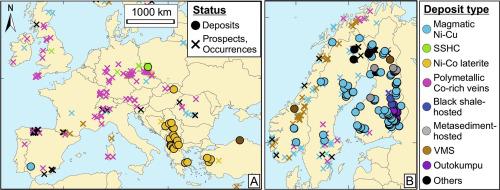当前位置:
X-MOL 学术
›
Ore Geol. Rev.
›
论文详情
Our official English website, www.x-mol.net, welcomes your feedback! (Note: you will need to create a separate account there.)
Cobalt resources in Europe and the potential for new discoveries
Ore Geology Reviews ( IF 3.3 ) Pub Date : 2021-03-01 , DOI: 10.1016/j.oregeorev.2020.103915 S. Horn , A.G. Gunn , E. Petavratzi , R.A. Shaw , P. Eilu , T. Törmänen , T. Bjerkgård , J.S. Sandstad , E. Jonsson , S. Kountourelis , F. Wall
Ore Geology Reviews ( IF 3.3 ) Pub Date : 2021-03-01 , DOI: 10.1016/j.oregeorev.2020.103915 S. Horn , A.G. Gunn , E. Petavratzi , R.A. Shaw , P. Eilu , T. Törmänen , T. Bjerkgård , J.S. Sandstad , E. Jonsson , S. Kountourelis , F. Wall

|
Abstract Global demand for cobalt is increasing rapidly as we transition to a low-carbon economy. In order to ensure secure and sustainable supplies of this critical metal there is considerable interest in Europe in understanding the availability of cobalt from indigenous resources. This study reviews information on cobalt resources in Europe and evaluates the potential for additional discoveries. Based on published information and a survey of national mineral resource agencies, 509 cobalt-bearing deposits and occurrences have been identified in 25 countries in Europe. Harmonised cobalt resources, classified using the United Nations Framework Classification (UNFC), have been estimated for 151 deposits in 12 countries where data are available. The calculated total resource comprises 1 342 649 tonnes of contained cobalt metal. This includes: 114 638 tonnes in commercial projects with current cobalt extraction; 370 409 tonnes in potentially commercial projects; 111 107 tonnes in historic estimates compliant with modern reporting; and 746 495 tonnes in non-compliant historic estimates. Analysis of these data reveals that cobalt resources are widely distributed across Europe in deposits of several different types. Global mine production of cobalt is dominated by stratiform sediment-hosted copper deposits, magmatic nickel-copper deposits and nickel laterite deposits, but other deposit types may also be significantly enriched in cobalt. In Europe, current cobalt production is derived from three mines in Finland: the magmatic sulfide deposit at Kevitsa; the Kylylahti deposit of volcanogenic massive sulfide (VMS) affinity; and the black shale-hosted deposit at Sotkamo (Talvivaara). This study has identified 104 deposits in Europe that are currently being explored for cobalt, of which 79 are located in Finland, Norway and Sweden. The Fennoscandian Shield and the Caledonian Belt in these countries are high priority exploration terrains for a variety of cobalt-bearing deposits, notably magmatic Ni-Cu-Co deposits. The Svecofennian, Sveconorwegian and the Caledonian orogenies in Fennoscandia also resulted in the formation of several other cobalt-enriched deposit types. These include chiefly metasediment- and metavolcanic-hosted Co-Cu-Au, VMS, skarn and polymetallic vein deposits. The Kupferschiefer deposits in Poland and Germany are stratiform sediment-hosted Cu deposits with some similarities to the Central African Copperbelt, which is the predominant global producer. However, the cobalt grade in the Kupferschiefer deposits is relatively low (0.005-0.008 % Co) and not currently economic to exploit without significant improvement in extraction technology. In the Balkans and Turkey cobalt grades and tonnages are known in 27 nickel laterite deposits, with several containing more than 10 000 tonnes of cobalt metal. Only nickel is currently recovered from these deposits, but new processing technologies such as high-pressure acid leaching could enable cobalt recovery in the future. Small polymetallic cobalt-bearing vein deposits in several European countries have been historic producers of cobalt. Today most are uneconomic, but new technologies and the drive towards locally-sourced raw materials could make them viable future sources of cobalt. Our analysis suggests that geological availability in Europe is not a problem. However, many economic, technological, environmental and social challenges will have to be overcome for exploration projects to become commercial.
中文翻译:

欧洲的钴资源和新发现的潜力
摘要 随着我们向低碳经济转型,全球对钴的需求正在迅速增加。为了确保这种关键金属的安全和可持续供应,欧洲对了解来自本地资源的钴的可用性非常感兴趣。本研究回顾了欧洲钴资源的信息,并评估了其他发现的潜力。根据已发布的信息和对国家矿产资源机构的调查,在欧洲 25 个国家已确定了 509 个含钴矿床和矿点。已使用联合国框架分类 (UNFC) 进行分类的协调钴资源估计为 12 个有数据的国家的 151 个矿床。计算的总资源量包括 1 342 649 吨所含钴金属。这包括:114 638 吨商业项目,目前有钴提取;370 409 吨潜在商业项目;111 107 吨符合现代报告的历史估计;和 746 495 吨不合规的历史估计。对这些数据的分析表明,钴资源广泛分布在欧洲的几种不同类型的矿床中。全球钴矿产量以层状沉积物为主的铜矿床、岩浆镍铜矿床和镍红土矿床为主,但其他矿床类型也可能显着富集钴。在欧洲,目前的钴产量来自芬兰的三个矿山:Kevitsa 的岩浆硫化物矿床;火山成因块状硫化物 (VMS) 亲和性的 Kylylahti 矿床;以及位于 Sotkamo (Talvivaara) 的黑色页岩矿床。这项研究确定了欧洲目前正在勘探的 104 个钴矿床,其中 79 个位于芬兰、挪威和瑞典。这些国家的 Fennoscandian 地盾和 Caledonian Belt 是各种含钴矿床,特别是岩浆 Ni-Cu-Co 矿床的优先勘探区域。Fennoscandia 的 Svecofennian、Sveconorwegian 和 Caledonian 造山运动也导致了其他几种富钴矿床类型的形成。这些主要包括变质沉积和变质火山的 Co-Cu-Au、VMS、矽卡岩和多金属脉矿床。波兰和德国的 Kupferschiefer 矿床是层状沉积物铜矿床,与中非铜带有一些相似之处,后者是全球主要生产商。然而,Kupferschiefer 矿床中的钴品位相对较低 (0.005-0.008 % Co),如果不显着改进提取技术,目前开采不经济。在巴尔干和土耳其,已知有 27 个红土镍矿床的钴品位和吨位,其中几个含有超过 10 000 吨的钴金属。目前只能从这些矿床中回收镍,但高压酸浸等新加工技术可以在未来实现钴的回收。几个欧洲国家的小型多金属钴矿脉矿床一直是钴的历史生产商。今天,大多数都是不经济的,但新技术和对本地采购原材料的推动可能使它们成为未来可行的钴来源。我们的分析表明,欧洲的地质可用性不是问题。
更新日期:2021-03-01
中文翻译:

欧洲的钴资源和新发现的潜力
摘要 随着我们向低碳经济转型,全球对钴的需求正在迅速增加。为了确保这种关键金属的安全和可持续供应,欧洲对了解来自本地资源的钴的可用性非常感兴趣。本研究回顾了欧洲钴资源的信息,并评估了其他发现的潜力。根据已发布的信息和对国家矿产资源机构的调查,在欧洲 25 个国家已确定了 509 个含钴矿床和矿点。已使用联合国框架分类 (UNFC) 进行分类的协调钴资源估计为 12 个有数据的国家的 151 个矿床。计算的总资源量包括 1 342 649 吨所含钴金属。这包括:114 638 吨商业项目,目前有钴提取;370 409 吨潜在商业项目;111 107 吨符合现代报告的历史估计;和 746 495 吨不合规的历史估计。对这些数据的分析表明,钴资源广泛分布在欧洲的几种不同类型的矿床中。全球钴矿产量以层状沉积物为主的铜矿床、岩浆镍铜矿床和镍红土矿床为主,但其他矿床类型也可能显着富集钴。在欧洲,目前的钴产量来自芬兰的三个矿山:Kevitsa 的岩浆硫化物矿床;火山成因块状硫化物 (VMS) 亲和性的 Kylylahti 矿床;以及位于 Sotkamo (Talvivaara) 的黑色页岩矿床。这项研究确定了欧洲目前正在勘探的 104 个钴矿床,其中 79 个位于芬兰、挪威和瑞典。这些国家的 Fennoscandian 地盾和 Caledonian Belt 是各种含钴矿床,特别是岩浆 Ni-Cu-Co 矿床的优先勘探区域。Fennoscandia 的 Svecofennian、Sveconorwegian 和 Caledonian 造山运动也导致了其他几种富钴矿床类型的形成。这些主要包括变质沉积和变质火山的 Co-Cu-Au、VMS、矽卡岩和多金属脉矿床。波兰和德国的 Kupferschiefer 矿床是层状沉积物铜矿床,与中非铜带有一些相似之处,后者是全球主要生产商。然而,Kupferschiefer 矿床中的钴品位相对较低 (0.005-0.008 % Co),如果不显着改进提取技术,目前开采不经济。在巴尔干和土耳其,已知有 27 个红土镍矿床的钴品位和吨位,其中几个含有超过 10 000 吨的钴金属。目前只能从这些矿床中回收镍,但高压酸浸等新加工技术可以在未来实现钴的回收。几个欧洲国家的小型多金属钴矿脉矿床一直是钴的历史生产商。今天,大多数都是不经济的,但新技术和对本地采购原材料的推动可能使它们成为未来可行的钴来源。我们的分析表明,欧洲的地质可用性不是问题。



























 京公网安备 11010802027423号
京公网安备 11010802027423号